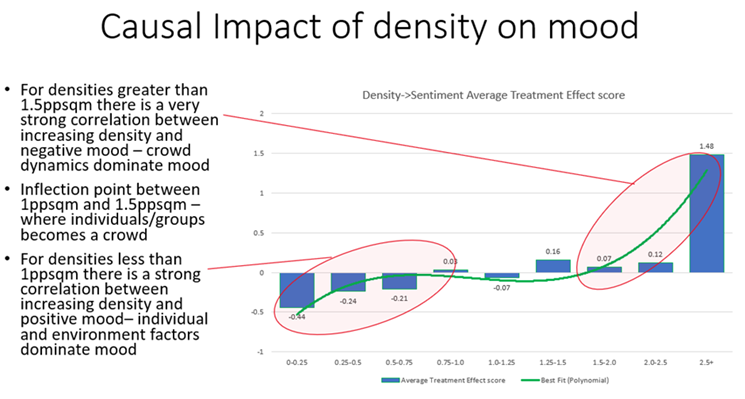Crowds can be unpleasant. Crowd managers improve user experience in crowded spaces and keep crowds safe. To date, they have done so by applying learnt experience in observing the movements of people in crowded spaces, trying to assess when and where a problem may be emerging. This can be difficult at ground level or in a control room and constantly scanning dozens of CCTV screens, presented as small two-dimensional images of variable quality. The images do not provide any reliable guide to the aggregated sentiment of people in the crowd and whether that mood is shifting such that a priority should be to relieve pressure in a particular area.
How can better data and advanced data analytics help crowd managers improve user experience and safety in crowded places?
Dynamic Crowd Measurement was supported by the NSW Government Smart Places Acceleration Program, to work in collaboration with partners at Sydney Olympic Park Authority and Transport NSW to address this problem. The project focused on measuring aggregated crowd sentiment to identify causal factors influencing crowd mood fluctuations and differentiate those inferred to relate to crowding, thereby providing an evidence base to guide crowd managers’ decisions about place management. And all of this needed to be done in a privacy-protected environment, so precinct operators and citizens were comfortable that they were free from intrusive surveillance of individuals.
And what are the causal factors influencing crowd mood fluctuations?
Despite the understanding among seasoned crowd managers of the relationship between crowd density and flow and their impact on mood, a comprehensive and reliable model demonstrating causal relationships has not been available previously. Causality in this context refers to the phenomenon where an influencing factor, such as crowd density, induces changes in another factor, namely mood. This is a non-linear relationship, and every crowd is complex and different to a certain extent, so this needs to be measured in real-time for effective management response.

We believe this is the first time the causal influence of density has been measured and modelled against mood changes for management intervention.
What did the study demonstrate?
For this project, the results showed that maintaining crowd density below 1.5 people per square meter (ppsqm) is a key factor in reducing the likelihood of negative moods. Crowd density is only one of the many factors that affect mood and sentiment. This study also modelled the relationship between crowd flow speed, weather conditions, on-ground reports and scanned social media feeds to model the impact on averaged crowd sentiment.
This multimodal infusion of information is the key to understanding complex relationships like crowd behaviour. We will discuss this further in the future. Notably, adverse weather conditions, particularly rain, were found to cause a strong negative sentiment that is challenging to overcome: you can’t change the weather!
Despite the variability in crowd composition, characteristics, and influences, the ability to measure mood provides place managers with real-time alerts, guiding interventions based on a sound evidence base. Ongoing efforts in this measurement aim to further develop and validate the scientific understanding of causality in human behaviour.
Our particular thanks to the Sydney Olympic Park Authority, including Susan Skuodas and Michael Copping, for their support of innovation, marking the initiation of a new era in understanding human behaviour and refining management responses, and for the assistance of the NSW Government’s Smart Places Acceleration Program.
Andrew Tatrai
Co-Founder of Dynamic Crowd Measurement
andrew@dynamiccrowdmeasurement.com


